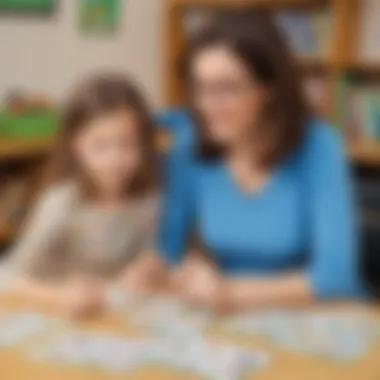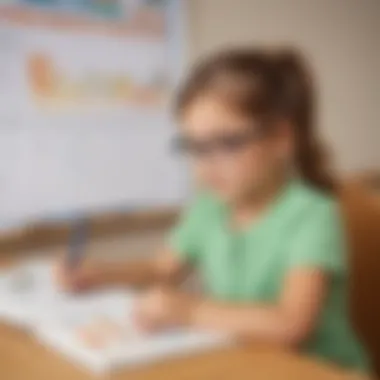Unraveling the Significance of Sight Words in Elementary Education


CreativeActivities
In exploring the concept of sight words in elementary education, it is essential to consider various creative activities that can aid in children's learning. Engaging young learners in craft ideas geared towards sight words can significantly enhance their understanding. By sharing innovative craft ideas that are easily replicable, children can actively participate in hands-on activities that reinforce their sight word recognition. Step-by-step guides detailing instructions for each craft activity ensure clarity and encourage children to develop their skills effectively. Moreover, discussing the educational value of these activities underscores the importance of incorporating sensory experiences into learning environments, promoting holistic development.
Fun Quizzes
When delving into the realm of sight words, incorporating fun quizzes can be an exciting and impactful approach to reinforce learning. By listing various quiz topics relevant to sight words on platforms like ElemFun, educators can engage children in interactive learning experiences. Explaining the diversity of question types used in these quizzes ensures that children encounter a variety of challenges that cater to different learning styles. Highlighting how these quizzes facilitate knowledge reinforcement underscores their role in solidifying sight word recognition and comprehension among young learners.
Fact-Based Articles
To supplement the understanding of sight words, exploring fact-based articles can provide insightful perspectives and valuable information. By covering a diverse array of topics related to sight words, such articles offer a comprehensive view of the subject matter. Describing how these articles present complex information in engaging and easy-to-understand formats enhances the accessibility of educational content for young readers. Additionally, providing links to additional resources enables further exploration and encourages continuous learning beyond the scope of traditional classroom settings.
Introduction
Defining Sight Words
Sight words, also known as high-frequency words or popcorn words, are common words that appear frequently in text and often do not follow conventional phonetic rules. Their recognition is vital as they form the backbone of reading fluency and comprehension. These words are typically memorized by sight rather than sounded out, providing young readers with a repertoire of words they can quickly recognize and understand within the context of sentences and passages. The ability to effortlessly identify sight words is considered a crucial skill in the early stages of reading acquisition, facilitating smoother decoding of text and enabling young learners to focus on comprehension rather than struggling with word recognition.
Basic Definition of Sight Words
Sight words constitute a core set of words that are essential for early reading success. They encompass frequently occurring words that young readers are encouraged to memorize due to their high utility in text comprehension. By internalizing these words, students can swiftly recognize them on sight, aiding in the development of reading fluency and confidence. The distinctiveness of sight words lies in their irregularities, as they often do not adhere to phonetic norms, necessitating rote memorization for accurate recall.
Sight Wor[odsf Importance no Reading]


Sight words hold immense significance [joyeq in reading development. By mastering these words, early readers can enhance their reading speed and comprehension, as they no longer need to decode these commonly occurring words. This streamlined recognition process enables students to focus on extracting meaning from text rather than getting bogged down by word identification. Moreover, sight words serve as building blocks for expanding vocabulary and developing more complex reading abilities. While some critics argue that an overemphasis on sight words may hinder phonetic development, their practical utility in facilitating reading fluency cannot be understated.
[ppiEnxalen era Common Sight Words] Common sight words encompass ubiquitous words such as 'the,' 'and,' 'said,' and 'you,' among others. These words recur frequently in both simplified and advanced texts, making them foundational elements of early literacy instruction. By introducing students to common sight words early on, educators empower them to navigate various reading materials with greater ease. The inclusion of sight words like 'they' and 'have' in early reading exercises enhances students' reading confidence and encourages independent word recognition skills.
Significance in Elementary Education
In the realm of elementary education, sight words hold immense significance [nfio] equipping students with essential reading skills and strategies. These words serve as the cornerstone of reading proficiency, nurturing young learners' ability to decode text fluently and comprehend written material effectively. Understanding the critical role of sight words in the educational landscape is key to implementing targeted instruction that optimizes students' reading capabilities.
Role of Sight Words in Reading Proficiency
The role of sight words in reading proficiency is instrumental, as these words form the scaffolding upon which students build their reading skills. By mastering sight words, students can swiftly identify common words in texts, leading to enhanced reading speed and comprehension. Sight words act as anchors for young readers, allowing them to navigate sentences and paragraphs with greater ease, thereby promoting smooth and efficient reading experiences.
Impact no Vocabulary Expansion
The impact of sight words on vocabulary expansion is profound, as these words serve as steppingstones for broadening students' word knowledge. By internalizing sight words, students not only enhance their reading fluency but also gain exposure to a diverse range of vocabulary. This exposure lays the groundwork for vocabulary acquisition and retention, enabling students to recognize and comprehend a myriad of words across various texts. Moreover, sight words contribute to the development of semantic connections and associations, fostering a deeper understanding of word meanings and usage within different contexts.
[Trietgraino ka Early Irtsy[devenm Ton nincglob[ea Adevtioenton] The integration of sight words in early literacy develop[an entp ssurves an vit[es atiposing students with foundational reading skills from the outset. By incorporating sight words into early literacy programs, educators empower y[oanns learirers to develope dorsd d dnmd nd ako at uniqout reading abilities. This early exposure lays the groundwork for future literacy success, as students cultivate proficient reading habits and build a strong, diverse vocabulary from the beginning of their educational journey.
Teaching Strategies In the intricate landscape of childhood learning, the foundation for knowledge acquisition is underscored by the selection of adequate teaching strategies. For an avant-garde discourse on imparting sight words to young learners, a mélange of methodologies is indispensable. These strategies are not mere pedagogical tools but the bedrock for fostering linguistic proficiency and cognitive development. By elucidating the salient themes surrounding teaching strategies, this article sheds light on the pivotal role they play in nurturing a child's literacy skills. Embracing an array of innovative techniques ensures a holistic educational experience that cultivates a love for reading in impressionable minds.
Effective Approaches to Teaching Sight Words In the realm of educational pedagogy, the essence of employing effective approaches cannot be overstated. When it comes to teaching sight words, diligence and precision reign supreme. Among the pantheon of strategies, Phonics-Based Instruction emerges as a venerable cornerstone. Its systematic approach to connecting sounds with letters not only fosters phonemic awareness but also lays a solid foundation for language acquisition. Multi-Sensory Techniques, on the other hand, add a tactile dimension to learning, engaging multiple senses to enhance retention and comprehension. Meanwhile, Repetitive Practice Methods, though seemingly mundane, instill a sense of automaticity crucial for rapid word recognition and fluency. These varied approaches converge to create a pedagogical tapestry that ensures a comprehensive understanding of sight words. ###
ics-Based Instruction Phonics-Based Instruction operates on the premise that deciphering the phonetic code of language unlocks the gateway to reading proficiency. By decoding the intricate relationship between sounds and letters, young learners establish a robust foundation for word recognition. The inherent logic and structure of phonics not only facilitate reading fluency but also bolster spelling skills. Despite its empirical efficacy, Phonics-Based Instruction demands meticulous practice and unwavering commitment from educators and students alike. Navigating through the phonemic intricacies can be daunting, yet the rewards of proficient reading skills far outweigh the initial challenges. #### Mul
sory Techniques Multi-Sensory Techniques epitomize the synergy of sensory modalities in the learning process. By integrating visual, auditory, and kinesthetic elements, these techniques cater to diverse learning styles, ensuring inclusivity in pedagogical practices. The meta-cognitive connections forged through multisensory experiences deepen comprehension and fortify neural pathways related to language processing. While the efficacy of Multi-Sensory Techniques in facilitating sight word mastery is irrefutable, the resource-intensive nature of these methods warrants careful consideration in educational planning. Balancing sensory engagement with academic rigor is paramount to harnessing the full potential of multi-sensory learning. #### Repetiti
ctice Methods Repetitive Practice Methods serve as the crucible in which sight words are refined and internalized. The iterative nature of this approach instills a sense of familiarity and automatism crucial for rapid word retrieval. Through deliberate and structured practice, young learners engrain sight words into their lexicon, enhancing reading fluency and comprehension. While the efficacy of Repetitive Practice Methods in solidifying sight word recognition is unparalleled, educators must strike a balance between repetition and engagement to prevent monotony and ensure sustained motivation. The judicious integration of diverse practice activities can transform rote learning into a dynamic and engaging educational journey. ### Incorporating
Words in Curriculum In the labyrinth of educational design, the seamless integration of sight words into the curriculum unveils a multitude of opportunities for holistic learning. Each facet of the curriculum, meticulously crafted and tailored to children's developmental stages, serves as a vessel for nurturing vocabulary expansion and reading acumen. By elucidating the pivotal role of sight words in curriculum planning, this article illuminates the transformative impact of incorporating targeted literacy activities into the educational framework. #### Integration in Re
Programs Integration in Reading Programs is akin to weaving a narrative tapestry that intertwines sight words with the fabric of storytelling and language exploration. By embedding sight words into thematic units and literary contexts, educators create a symbiotic relationship between language acquisition and narrative fluency. The synergistic interplay between sight words and contextual reading not only enriches vocabulary but also fosters a deep appreciation for the nuances of language. While the seamless integration of sight words in reading programs bolsters reading comprehension, educators must tread the fine line between structured literacy instruction and free-form exploration to cultivate well-rounded literacy skills. #### Interactive Learning R
es Interactive Learning Resources epitomize the marriage of technology and pedagogy, offering a dynamic platform for engaging young learners in sight word mastery. Through interactive games, digital flashcards, and virtual simulations, students embark on an immersive learning journey that transcends traditional classroom boundaries. The interactive nature of these resources not only captivates young minds but also augments retention and application of sight word knowledge. While the allure of interactive learning resources lies in their engagement value, educators must exercise prudence in balancing screen time with traditional literacy activities to optimize learning outcomes. Nurturing a symbiotic relationship between virtual interactivity and hands-on learning experiences is key to harnessing the full potential of digital resources in sight word instruction. #### Assessment and Monitoring
sment and Monitoring constitute the compass that navigates the pedagogical voyage towards sight word proficiency. By evaluating student progress, diagnosing learning gaps, and tracking developmental milestones, educators gain invaluable insights into each child's educational trajectory. Timely and targeted assessments not only gauge sight word acquisition but also inform instructional planning, allowing educators to tailor interventions to meet individual learning needs effectively. While the implementation of assessment and monitoring protocols is indispensable in promoting data-driven instruction, a judicious balance must be struck between formative assessments and summative evaluations to ensure a comprehensive understanding of student growth and performance. Embracing a holistic approach to assessment empowers educators to support student success and foster a culture of continuous improvement in sight word instruction.
Benefits of Mastering Sight Words
Understanding the importance of mastering sight words is crucial for young learners in their reading development. Sight words play a fundamental role in enhancing reading proficiency and comprehension, contributing significantly to overall literacy skills. By mastering sight words, students can improve their reading fluency, accuracy, and retention of information, thus building a strong foundation for advanced literacy skills. Moreover, mastering sight words boosts students' confidence in their reading abilities, enabling them to tackle more complex texts with ease and understanding. Through a systematic approach to sight word mastery, educators can effectively support students in their journey towards becoming proficient readers.


Enhanced Reading Comprehension
Facilitation of Fluency and Accuracy
Understanding sight words is essential for facilitating fluency and accuracy in reading. By recognizing sight words instantly, readers can navigate through texts more smoothly, enhancing their reading speed and comprehension. The automatic recognition of sight words reduces the cognitive load on readers, allowing them to focus on understanding the meaning of the text rather than decoding individual words. This fluency and accuracy ultimately contribute to improved reading comprehension and engagement with various types of literature.
Improved Retention and Recall
Improved retention and recall are key benefits of mastering sight words. When students can quickly identify and understand sight words, they are more likely to remember them in the long term. This enhanced retention leads to greater reading fluency and comprehension, as readers can effortlessly recall familiar words while progressing through texts. The mastery of sight words creates a strong foundation for building vocabulary and understanding complex concepts across different subject areas.
Development of Reading Stamina
Developing reading stamina is another significant outcome of mastering sight words. As students become proficient in recognizing sight words, they can sustain their focus and comprehension over extended reading periods. Reading stamina enables readers to dive into more extensive texts, engage with complex ideas, and extract meaning from in-depth passages. By continuously practicing and reinforcing sight word recognition, students can enhance their reading endurance and delve into challenging literary works with confidence.
Boosting Overall Literacy Skills
Expanded Vocabulary Acquisition
A crucial aspect of mastering sight words is the expanded vocabulary acquisition it offers. Through the repetitive exposure to sight words, students not only enhance their word recognition skills but also increase their vocabulary breadth. The ability to quickly identify and understand sight words paves the way for better comprehension of varied texts and allows students to interpret unfamiliar words within context. This expanded vocabulary acquisition lays a solid foundation for academic success and lifelong learning.
Increased Confidence in Reading
Mastering sight words boosts students' confidence in their reading abilities. As students progress in recognizing and applying sight words in their reading, they feel more assured and prepared to tackle complex texts independently. Increased confidence leads to greater interest in reading activities, promoting a positive attitude towards literacy and learning. The sense of accomplishment derived from mastering sight words empowers students to explore new literary genres, participate actively in class discussions, and embrace reading as a rewarding and enjoyable experience.


Challenges and Remedies
Sight words play a crucial role in the development of young learners' reading skills. Understanding and addressing the challenges that may arise when learning sight words is essential for educators and parents. By overcoming these difficulties effectively, students can improve their reading proficiency and overall literacy skills. One common challenge is the variety of sight words that young learners need to memorize. This can be overwhelming for some students, leading to frustration and slower progress in reading development. Additionally, difficulties may arise due to the abstract nature of sight words, making it challenging for students to grasp their meanings and usage correctly. To remedy these challenges, educators can implement personalized strategies tailored to individual students' needs. Providing targeted support and practice sessions can help students overcome these hurdles and master sight words more effectively.
Overcoming Sight Words Difficulties: Addressing Reading Struggles
Addressing reading struggles is a fundamental aspect of helping students overcome sight words difficulties. This approach focuses on identifying specific challenges that students face when learning sight words, such as pronunciation issues, comprehension gaps, or struggles with retention. By pinpointing these struggles early on, educators can create targeted intervention plans to address them effectively. The key characteristic of addressing reading struggles is its personalized nature, tailoring support to each student's unique needs. This approach is beneficial as it allows educators to tackle individual problems directly, leading to improved learning outcomes. However, one disadvantage is the time and resources required to implement personalized strategies for each student. Despite this challenge, addressing reading struggles remains a popular choice for educators due to its proven effectiveness in improving sight words mastery.
Overcoming Sight Words Difficulties: Utilizing Differentiated Instruction
Utilizing differentiated instruction is another valuable approach in helping students navigate sight words difficulties. This method involves customizing teaching techniques and resources based on students' learning styles, abilities, and interests. By providing a variety of instructional methods, educators can cater to diverse student needs and preferences, making the learning process more engaging and effective. The unique feature of differentiated instruction lies in its flexibility and adaptability to accommodate varying learning paces and preferences. This versatility allows educators to create a dynamic learning environment that meets the specific needs of each student. While differentiated instruction offers many advantages in promoting sight words mastery, such as increased engagement and personalized learning, it may also pose challenges in terms of planning and organizing instruction for a diverse classroom.
Overcoming Sight Words Difficulties: Seeking Support from Educators and Parents
Seeking support from educators and parents is a collaborative approach to helping students overcome sight words difficulties. By involving both educational professionals and caregivers in the learning process, students can receive comprehensive support both at school and at home. The key characteristic of seeking support from educators and parents is the holistic approach to student development, bridging the gap between classroom learning and home reinforcement. This collaborative effort benefits students by providing consistent guidance and practice opportunities in different settings. One unique feature of seeking support from both educators and parents is the alignment of teaching strategies and reinforcement techniques, creating a cohesive learning environment for students. While this approach offers significant advantages in terms of consistent support and reinforcement, challenges may arise in coordinating communication and resources between educators and parents.
Conclusion
Summarizing the Importance of Sight Words
Key Takeaways on Sight Words
Key takeaways on sight words encapsulate the crux of their influence on reading progression. These fundamental words form the bedrock of comprehension and fluency, acting as building blocks for a child's literacy development. Understanding sight words establishes a strong foundation in decoding texts, fostering smoother reading experiences for young learners. Their repetitive inclusion in educational curricula underscores the critical role they play in honing reading skills and boosting overall literacy.
Encouragement for Continued Practice
Encouraging consistent practice of sight words is paramount in solidifying reading capabilities. By instilling a sense of perseverance and diligence, educators and caregivers can empower students to strengthen their word recognition abilities continuously. Regular practice not only enhances retention but also cultivates confidence and fluency in reading. The encouragement for sustained engagement with sight words sets the stage for continual progress and proficiency in literacy.
Future Implications for Reading Proficiency
The future implications of mastering sight words extend beyond immediate academic endeavors. Proficiency in sight words lays a resilient groundwork for enhanced reading skills throughout a student's educational journey. The ability to swiftly recognize and interpret these core vocabulary words fosters a deeper understanding of texts, leading to advanced comprehension and critical thinking skills. Embracing the significance of sight words today foretells a future imbued with robust reading proficiency and cognitive acumen.







